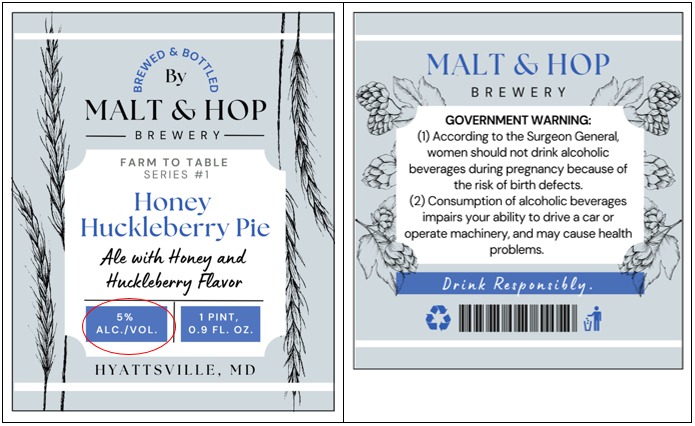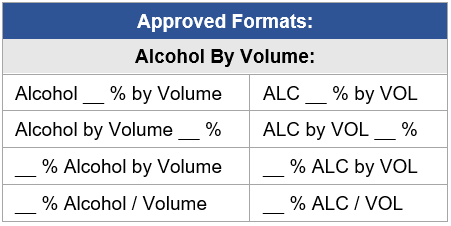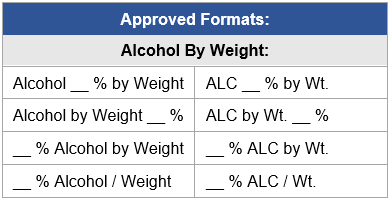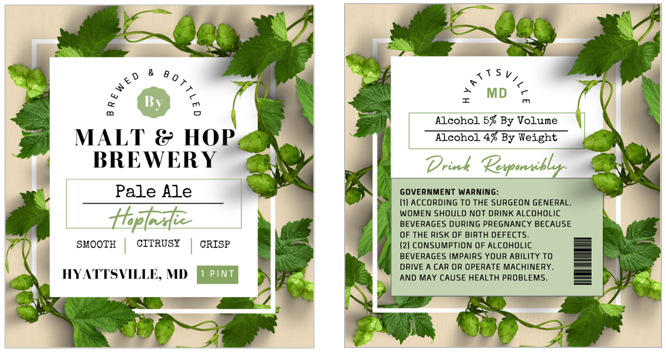Alcohol content is a numerical statement on a malt beverage label that indicates the amount of alcohol in the product. As described below, TTB requires the alcohol content of a malt beverage to be stated, in terms of alcohol by volume, under certain circumstances.
When a compliant alcohol by volume statement is used, additional optional expressions of alcohol content, for example, alcohol by weight, also may appear on the label, as described below.
When is an alcohol content statement mandatory?
TTB requires an alcohol by volume statement whenever a malt beverage contains any alcohol derived from added flavors or other added nonbeverage ingredients containing alcohol (other than hops extract). See 27 CFR 7.63(a)(3). Otherwise, an alcohol by volume statement is optional (unless required or prohibited by State law).
Where should the alcohol content statement be placed on the product?
The alcohol content statement may appear on any label.

In the example above, the alcohol content statement is mandatory because the malt beverage product contains alcohol from the huckleberry flavor.
Is a range of the alcohol content permitted?
No, alcohol content statements may not be expressed as a range or as maximum or minimum values.
What are the formatting requirements?
Unless different requirements are provided for under State law, the formatting of alcohol by volume statements must comply with the following requirements in accordance with 27 CFR 7.65. The following requirements also apply:
- Only alc. and vol. (with or without periods) may be used to abbreviate the words alcohol and volume.
- The abbreviation “ABV” is not allowed.
- Percent may be represented by the percent symbol “%.”
- Alcohol and volume may be separated by a slash (“/”) in lieu of the word “by.”
- The words (or abbreviations) may appear in capital letters or lower case letters.
- The numerical alcohol content may precede or follow the term “alcohol” or “alc.”
Acceptable examples of alcohol by volume statements include:

Type Size
Unless otherwise required by State law:
- Minimum 1 mm for containers of 1/2 pint or less
- Minimum 2 mm for containers larger than 1/2 pint
- Maximum 3 mm for containers of 40 fl. oz. or less
- Maximum 4 mm for containers larger than 40 fl. oz.
Note: While the maximum type size requirements extend to both mandatory and optional statements of alcohol content, the minimum type requirements only apply to mandatory alcohol content statement. The minimum type size applies to each numeral or letter in the statement, including both upper-case and lower-case letters. See 27 CFR 7.53.
Legibility
When an alcohol content statement is required by TTB, it must be:
- Readily legible under ordinary conditions;
- Separate and apart from additional information; and
- Located on a contrasting background.
More information on these requirements is available at 27 CFR 7.52.
How must alcohol content statements be expressed?
For malt beverages containing 0.5 percent or more alcohol by volume, statements of alcohol content must be expressed to the nearest one-tenth of one percent. For malt beverages containing less than 0.5 percent alcohol by volume, alcohol content may be expressed either to the nearest one-tenth or the nearest one-hundredth of one percent. See 27 CFR 7.65(b)(2).
May I put a statement of alcohol by weight on my product label?
Other truthful, accurate, and specific factual representations of alcohol content, including alcohol by weight, are permitted, as long as they appear together with, and as part of, the statement of alcohol content as a percentage of alcohol by volume. See 27 CFR 7.65(b)(1). A statement of alcohol by weight is therefore optional unless required or prohibited by State Law.
If an alcohol by weight statement is used, TTB recommends stating it in the same format as the alcohol by volume statement. Additionally, the abbreviation “ABW” is not allowed.
Acceptable examples of alcohol by weight statements include:

Example:

In the example label above, the alcohol by volume is stated as 5% and the alcohol by weight is stated as 4%.
What other statements may I use to describe the alcohol content of a malt beverage?
The following additional terms may be used to describe the alcohol content of malt beverages. See 27 CFR 7.65(d)–(f).
- “Low alcohol” or “reduced alcohol.” These terms may be used only on labels of malt beverages containing less than 2.5 percent alcohol by volume. The actual alcohol content may not equal or exceed 2.5 percent alcohol by volume, regardless of any tolerance permitted at 27 CFR 7.65(c).
- “Non-alcoholic.” This term may be used on labels of malt beverages only if the statement “contains less than 0.5 percent (or .5%) alcohol by volume” appears immediately adjacent to it, in readily legible printing, and on a completely contrasting background.
- “Alcohol free.” The term “alcohol free” may be used only on malt beverages containing no alcohol.
Other descriptions or terms relating to alcohol content of malt beverages are permitted as long as they are truthful and non-misleading. See T.D. TTB–158 (85 FR 18704, April 2, 2020).
What are the tolerances for alcohol content statements?
For malt beverages containing 0.5% or more alcohol by volume, a tolerance of 0.3% above or below the alcohol content stated on the label is permitted, either above or below the stated alcohol content, except that:
- A malt beverage labeled as containing 0.5% or more alcohol by volume may not contain less than 0.5% alcohol by volume
- A malt beverage labeled as “low alcohol” or “reduced alcohol” may not contain 2.5% or more alcohol by volume.
For malt beverages labeled as “non-alcoholic,” and therefore containing less than 0.5% alcohol by volume, the actual alcohol content may not exceed the labeled alcohol content. Malt beverages labeled as “alcohol free” must contain no alcohol. See 27 CFR 7.65(d)–(f).
Page last reviewed: March 21, 2023
Page last updated: March 21, 2023
Maintained by: Alcohol Labeling and Formulation Division

